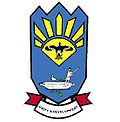Rundu | |
|---|---|
Town | |
 Aerial view of Rundu, 2019 | |
| Nickname: Ru-town | |
| Motto(s): Unity & Development | |
| Coordinates: 17°55′S19°46′E / 17.917°S 19.767°E | |
| Country | |
| Region | Kavango-East Region |
| Constituency | Rundu Urban constituency |
| Established | 1936 |
| Government | |
| • Type | Mayor-council government |
| • Mayor | Verna Mpingana Sinimbo (SWAPO) |
| Area | |
• Total | 156 km2 (60 sq mi) |
| Elevation | 1,095 m (3,593 ft) |
| Population | |
• Total | 118,625 |
| • Density | 760/km2 (1,970/sq mi) |
| Time zone | UTC+2 (SAST) |
| Area code | 066 |
| Climate | BSh |
| Website | runducity |

Rundu is the capital and the largest city of the Kavango-East Region in northern Namibia. It lies on the border with Angola on the banks of the Kavango River, about 1,000 metres (3,300 feet) above sea level. Rundu's population is growing rapidly. The 2001 census counted 36,964 inhabitants; [3] and for the 2011 census it climbed to 63,430.


